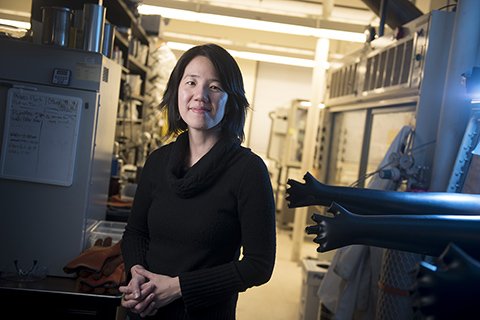Connie Lu: Changing times

Written by Kermit Pattison
March 6, 2017
The times were changing when Connie Lu entered academia.
Lu, associate professor of chemistry, became accustomed to academic rigor at an early age. She grew up as the second of three daughters in a family that had emigrated from Taiwan. Her father, unsatisfied with the curriculum in the suburban Miami public school they attended, assigned his daughters extra math homework. “My father gave us textbooks and expected us to learn,” Lu recalls with a laugh. “He wasn’t actually a great teacher, but he had high demands. I guess that’s where my problem solving skills really started.”
It paid off. The two eldest daughters both went to MIT.
“I only had two female professors in the department of chemistry,” Lu recalls. “They were giants in their field, but I knew they didn’t have families. There was definitely a disconnect between how I saw my male professors living versus how I saw my female professors living.”
She was not the only one who noticed the disparity. In the 1990s, a group of women faculty at MIT began discussing their shared career challenges and prompted the university to investigate gender equity at one of the world’s premier technological institutions. A committee investigated and reported subtle but pervasive discrimination, much of it unconscious. Junior women faculty reported that family-work con-flicts impacted their careers differently from male colleagues. Senior tenured women faculty felt marginalized and excluded from their departments. Data revealed disparities in salary, workspace, awards, and resources. The MIT administration embarked on a series of reforms to create a more equitable environment. The report drew national attention and sparked discussion and policy changes across academia.
Lu decided to pursue an academic career just as mindsets began to change. In graduate school at the California Institute of Technology, Lu saw female colleagues a few years ahead of her getting tenure-track jobs. “Because of that momentum, I never felt I had to break barriers,” she said. “It was changing.”
In 2009, Lu joined the faculty at the University of Minnesota. Her contract guaranteed a position for her husband, an astrophysicist. Lu’s research explores how simple gases, such as dinitrogen (N2) and carbon dioxide (CO2), may be converted into useful chemicals. Her team seeks to innovate new types of catalysts; potential applications include alternative fuels or industrial processes.
She also hopes to catalyze interest in science among young women. Her department has a chapter of Women in Science and Engineering (WISE), which holds an annual workshop for middle school girls. The students conduct hands-on experiments, such as making soap, creating glowing chemicals, and using liquid nitrogen to make ice cream—then eating it. She also serves on the department diversity committee.
In 2012, Lu and her husband had a daughter. Her department gave her a respite from teaching responsibilities for the semester and has continued to do so with other young parents. “That was a huge relief,” said Lu. “That made my life a whole lot simpler.”
